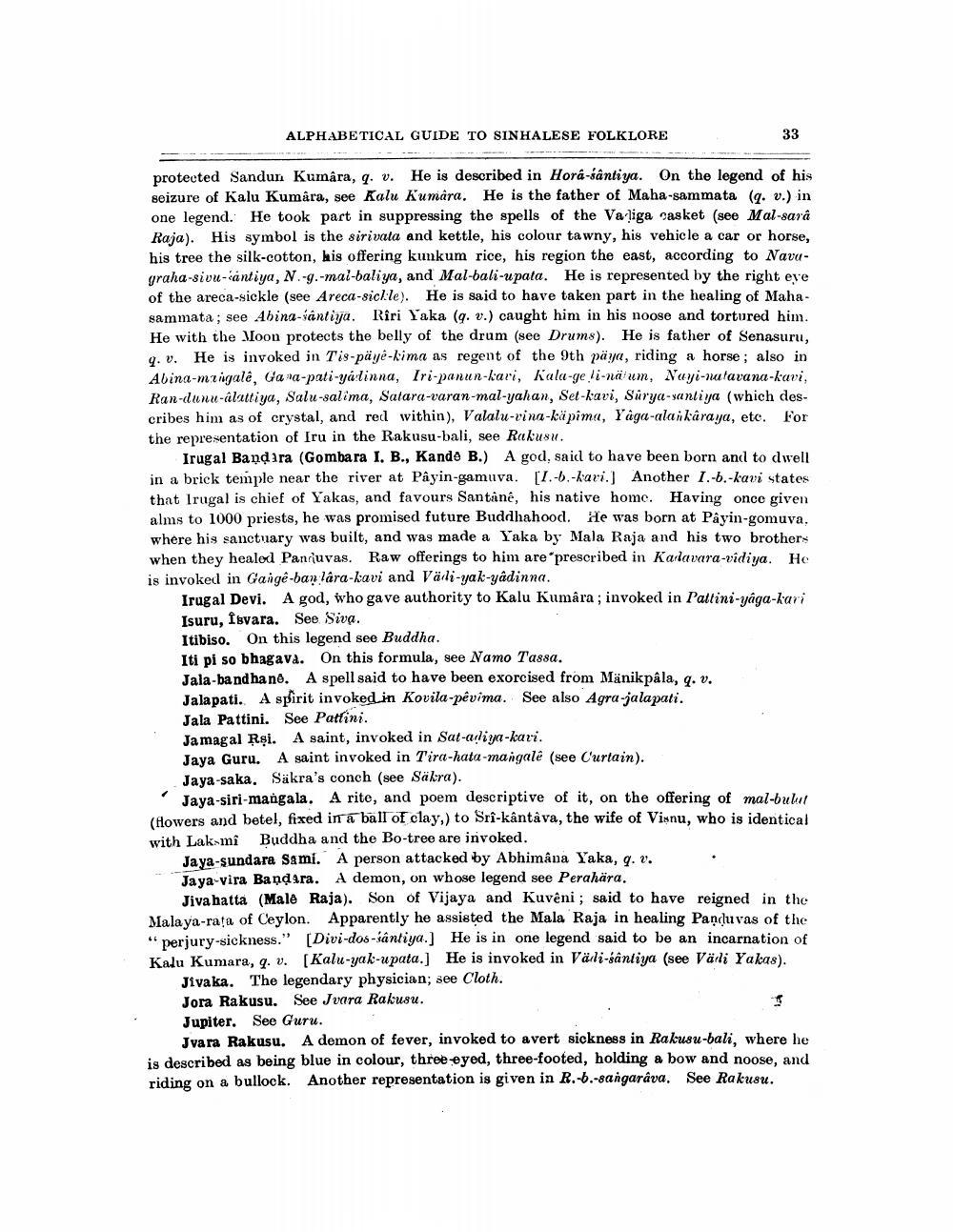________________
ALPHABETICAL GUIDE TO SINHALESE FOLKLORE
33
protected Sandun Kumara, q. v. He is described in Hora-śântiya. On the legend of his seizure of Kalu Kumara, see Kalu Kumara. He is the father of Maha-sammata (q. v.) in one legend. He took part in suppressing the spells of the Valiga rasket (see Mal-sará Raja). His symbol is the sirivata and kettle, his colour tawny, his vehicle a car or horse, his tree the silk-cotton, his offering kunkum rice, his region the east, according to Navagraha-sivu-cantiya, N.-9.-mal-baliya, and Mal-bali-upata. He is represented by the right eve of the areca-sickle (see Areca-sickle). He is said to have taken part in the healing of Mahasammata; see Abina-santiya. Riri Yaka (q. v.) caught him in his noose and tortured him. He with the Moon protects the belly of the drum (see Drums). He is father of Senasuru. 9. v. He is invoked in Tis-päyê-kima as regent of the 9th paya, riding a horse ; also in Abina-mzigalê, Gara-pati-yatinna, Iri-panun-kari, Kala-geli-narum, Nayi-sulavana-kavi, Ran-dunu-alattiya, Salu-salima, Satara-varan-mal-yahan, Set-kavi, Surya-santiya (which describes him as of crystal, and red within), Valalu-vina-käpima, Yaga-ala i karaya, etc. For the representation of Iru in the Rakusu-bali, see Rakusul.
Irugal Bandara (Gombara I, B., Kande B.) A god, said to have been born and to dwell in a brick temple near the river at Payin-gamuya. [I.-.-kari.] Another I.-.-kavi states that Irugal is chief of Yakas, and favours Santané, his native home. Having once given alms to 1000 priests, he was promised future Buddhahood. He was born at Payin-gomuva. where his sanctuary was built, and was made a Yaka by Mala Raja and his two brothers when they healed Panriuvas. Raw offerings to him are prescribed in Karlavara-vidiya. He is invoked in Gange-ban lara-kavi and Värli-yak-yadinna.
Irugal Devi. A god, who gave authority to Kalu Kumara; invoked in Pattini-yaga-kari Isuru, Isvara. See Siva. Itibiso. On this legend see Buddha. Iti pi so bhagava. On this formula, see Namo Tassa. Jala-band hano. A spell said to have been exorcised from Manikpala, q.v. Jalapati. A spirit invoked in Kovila-pêvima. See also Agra-jalapati. Jala Pattini. See Pattini. Ja mag al Rşi. A saint, invoked in Sat-aliya-kari. Jaya Guru. A saint invoked in Tira-hata-mangale (see Curtain). Jaya-saka. Säkra's conch (see Säkra).
Jaya-siri-mangala. A rite, and poem descriptive of it, on the offering of mal-bulut (Aowers and betel, fixed in a ball of clay,) to Sri-kantava, the wife of Visnu, who is identical with Laksmî Buddha and the Bo-tree are invoked.
Jaya-sundara Sami. A person attacked by Abhimâna Yaka, q. v. Jaya-vira Bandara. A demon, on whose legend see Perahära.
Jiva hatta (Male Raja). Son of Vijaya and Kuvêni; said to have reigned in the Mala ya-rata of Ceylon. Apparently he assisted the Mala Raja in healing Panduvas of the " perjury-sickness.” [Divi-dos-santiya.] He is in one legend said to be an incarnation of Kalu Kumara, q. v. (Kalu-yak-upata.] He is invoked in Värli-santiya (see Värli Yakas).
Jivaka. The legendary physician, see Cloth. Jora Rakusu. See Jvara Rakusu. Jupiter. See Guru.
Jvara Rakusu. A demon of fever, invoked to avert sickness in Rakusu-bali, where he is described as being blue in colour, three eyed, three-footed, holding a bow and noose, and riding on a bullock. Another representation is given in R.-6.-sangaráva. See Rakusu.




